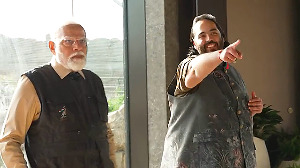According to the security agencies, Farooqi was killed during an encounter with paramilitary forces who had surrounded a rented house in Nawabshah in Sindh, where he along with some others had been living for the last two months.
On August 20, Pakistani authorities had announced cash rewards amounting to Rs 20 million each ($344,800) to anyone who provided information leading to the capture of Farooqi, a Pakistani national, and Abu Faraj al-Libbi, a Libyan national said to belong to Al Qaeda.
Farooqi was accused of acting at the instance of the Libyan in his attempts to kill Musharraf.
'We eliminated one of the very major sources of terrorist attacks. He was not only involved on attacks on me, but also on attacks elsewhere in the country. So a very big terrorist has been eliminated,' Musharraf told journalists at The Hague September 27.
All accounts from Nawabshah indicate that if the Pakistani authorities had wanted they could have caught Farooqi alive, and questioned him about the role of Pakistani civilian and military officials in the various terrorist incidents of the last three years.
These include the kidnapping and murder of journalist Daniel Pearl, the attempts to kill Musharraf and Prime Minister Shaukat Aziz, and the attacks directed against American and French targets.
Pak had cleared suicide bomber
But they did not want him alive.
In a report in The News of September 28 titled 'Real conspirators in Musharraf case may never be exposed,' Kamran Khan, the Pakistani investigative journalist, said: 'Senior lawyers say that the killing of Amjad Farooqi, the main accused in President Musharraf and Daniel Pearl cases, may also influence the final outcome of the two most important cases.
'A nationwide military investigation launched after two assassination attempts against President Pervez Musharraf last year had unveiled that some civilian and low level military individuals were the field operatives while Amjad Farooqi played an anchor in the abortive bids on Gen Musharraf's life.
'Because of the most sensitive nature of the probe the principal investigative work was carried out under the supervision of the Commander Corps 10, who received inputs from all federal and provincial law enforcement agencies in the most extensive investigation of a crime case in Pakistan,' Khan said.
'"It was very important to catch Amjad Farooqi alive,"' Khan quoted a senior law enforcement official as saying. '"Farooqi was the key link between the foot soldiers and those who ordered the murder."'
'"Amjad Farooqi is now dead with the most important secret and we still don't know for sure the real identity of the Pakistani or Al Qaeda or any other foreign elements who had launched Farooqi into action to remove General Musharraf from the scene," said another senior law enforcement official.'
Some circumstantial evidence collected during the investigation of President Musharraf case had cited some connection between Farooqi and Abu Feraj, an Al Qaeda operative of Libyan origin, hence the suspicion that Al Qaeda could be behind the murder attempts through Farooqi.
Pakistani officials believed that, like in the murder attempts against the president, Farooqi was an anchor in the Pearl case.
'The gruesome murder of Pearl and its video filming for the world was the work of Amjad Farooqi-Khalid Sheikh Mohammad combine,' said a senior intelligence official who did not want to be identified.
The truth will now never be known. Somebody in the Pakistani military-intelligence-police establishment did not want the truth to be known.
Why?
Who was Farooqi?
What were his links with the Pakistan army, the Inter-Services Intelligence and others in Pakistan?
To which organisation did he belong?
To answer those questions, we need to go back in time.
Flashback
In April 1992, the coalition of Afghan mujahideen groups, taking advantage of the revolt of Rashid Dostum, the Uzbek commander, against Najibullah, then the president of Afghanistan, invaded and captured Kabul.
Najibullah, who was overthrown from power, was taken by the United Nations into its protective custody and kept in its office in Kabul. UN efforts to persuade the mujahideen to allow Najibullah to go to India, where his family was living, failed.
The mujahideen's success in capturing power was made possible by the assistance of a large number of jihadis from Pakistani madrasas, who had been trained and armed by the ISI and sent into Afghanistan to help the mujahideen.
The Pakistani contingents, which participated in the invasion of Kabul, belonged to the anti-Shia Sipah-e-Sahaba Pakistan (SSP), the Harkat-ul-Ansar (HuA), as the Harkat-ul-Mujahideen was then known, and the Lashkar-e-Tayiba (LeT).
Amjad Farooqi, then an 18-year-old youth, entered Kabul as a member of the contingent of the SSP.
In 1994, there was a serious failure of the Pakistani cotton crop, which threatened to bring its textile industry to a standstill. Asif Zardari, then Pakistan prime minister Benazir Bhutto's husband, flew into Turkmenistan and entered into a contract for the purchase of a large quantity of cotton.
The Turkmenistan authorities wanted to send the cotton to Iran and from there ship it to Karachi. Zardari did not agree. Instead, he asked them to send the cotton by road via Afghanistan. He had the contract for the road transport of the cotton awarded to a Pakistani crony of his based in Hong Kong.
The first two cotton convoys from Turkmenistan were looted by mujahideen groups operating in the Herat area of Afghanistan.
Zardari thereupon sent Major General Nasirullah Babbar (retd), Benazir Bhutto's interior minister, and Pervez Musharraf to Afghanistan to provide protection to the cotton convoys. They asked Mulla Mohammad Omar, who subsequently became the amir of the Taliban, to collect a large number of students (Talibs) from the madrasas of Pakistan and constitute them into a force for the protection of the cotton convoys.
Thus the Taliban was born.
Interview: Mullah Mohammad Omar
Babbar and Musharraf, who had heard of Amjad Farooqi's exploits in Kabul in 1992, asked him to help Mulla Omar in organising this convoy protection force. He did so. Babbar travelled with the first convoy after this arrangement came into force and Amjad Farooqi and his boys escorted it.
A few months later, Mulla Omar deputed Farooqi to raid Herat and capture it with the help of his boys. He did so without difficulty, to the pleasant surprise of many, including the ISI.
Thus, from a cotton convoy protection force, the Taliban became the ruler of Kandahar and Herat and other areas. Assisted by Amjad Farooqi and his associates, it started gradually extending its administrative control to other areas.
In the beginning of 1995, Amjad Farooqi left the SSP and joined the HuA. The HuA sent him along with some others into India's Jammu & Kashmir, where they, under the name Al Faran, kidnapped a group of Western tourists.
Fate of hostages remains a mystery
One of the tourists was beheaded and another managed to escape. The fate of the remaining is not known till today. They are believed to have been beheaded and buried, but this has not been confirmed.
In October 1995, General Abdul Waheed Kakkar, the then chief of the army staff under Benazir Bhutto, discovered a plot by a group of army officers headed by Major General Zaheer-ul-Islam Abbasi to have him and Benazir assassinated, capture power and proclaim the formation of an Islamic Caliphate in Pakistan and Afghanistan.
Abbasi and his army associates were arrested. They were found to have been plotting in tandem with a group in the HuA led by Qari Saifullah Akhtar. But while Abbasi and his associates were court-martialled and sentenced to various terms of imprisonment, the Qari was released without any action being taken against him.
Before 1990, there were two jihadi organisations called the Harkat-ul-Mujahideen (HuM) and the Harkat-ul-Jihad-Al-Islami (HuJI). The HuM was headed by Maulana Fazlur Rahman Khalil and the HuJI by Qari Saifullah Akhtar.
Around 1990, the two merged to form the HuA, with Maulana Khalil as the amir and Qari Akhtar as the deputy amir. Amjad Farooqi used to work closely with the Qari.
In the late 1980s, Abbasi as a brigadier was posted to the Pakistani high commission in New Delhi as head of the ISI station in India. The Government of India had him expelled. On his return to Pakistan, he was posted to the Northern Areas (Gilgit and Baltistan).
In the beginning of the 1990s, without the clearance of General Asif Nawaz Janjua, the then COAS under Nawaz Sharif, Abbasi organised a raid on an Indian Army post in the Siachen area and was beaten back by the Indian Army with heavy casualties.
Janjua had him transferred out and censured. Since then, he had been nursing an anger against the Pakistan army's senior leadership and hobnobbing with the Qari.
A few months after capturing power on October 12,1999, Musharraf had Abbasi released from jail. He formed an anti-US organisation called Hizbollah, which acted in tandem with the HUJI.
In September 1996, the Taliban captured Jalalabad and Kabul. A large number of jihadi students from the Pakistani madrasas joined the Taliban unit which invaded and captured Kabul. Amjad Farooqi joined the unit at the head of a contingent of the HUA.
After capturing Kabul, Amjad Farooqi and his boys raided the UN office, where Najibullah was living, lynched him and hung him from a lamp-post.
When the Taliban, with the help of the madrasa students from Pakistan, captured Jalalabad, Osama bin Laden was living there. He had been permitted by the Burhanuddin Rabbani government, which was in power in Kabul till September 1996, to enter Afghanistan and take up residence in Jalalabad. It had taken of the Benazir Bhutto government's clearance to do so.
Pak helped Taliban prop al Qaeda: 9/11 panel
After capturing Jalalabad, the Taliban had bin Laden shifted to Kandahar by Amjad Farooqi and his men.
In October 1997, after establishing the involvement of the HuA in the 1995 kidnapping, the US state department designated it as a Foreign Terrorist Organisation under a 1996 US law. The HuA thereupon dissolved itself and the pre-1990 HuM and HuJI resumed their original existence under their previous names. Qari Saifullah Akhtar took over as amir of the HuJI and made Amjad Farooqi his deputy.
In February 1998, bin Laden announced the formation of his International Islamic Front for Jihad Against the Crusaders and the Jewish People. Among those who joined it at its inception were the HuM and a Bangladesh branch of the HuJI, identified as HuJI (B).
The Pakistani branch of the HuJI, the Lashkar and the SSP joined it in 1999. Amjad Farooqi used to represent the Qari at the meetings of the IIF's shoora (consultative council).
In December 1999, a group of Pakistani hijackers, said to be belonging to the HuM, hijacked an aircraft of the Indian Airlines, which had taken off from Kathmandu, and forced the pilot to fly it to Kandahar. They demanded the release of Omar Sheikh, a British Muslim of Pakistani origin, and Maulana Masood Azhar, a Pakistani Punjabi belonging to the HuM.
The Government of India conceded their demands in order to terminate the hijacking.
Amongst the hijackers was a Pakistani Punjabi by name Mansur Hasnain. Sections of the Pakistani media reported that this hijacker was none other than Amjad Farooqi.
After their release from detention by the Indian authorities, Maulana Azhar and Omar Sheikh went to Pakistan. The return of Azhar led to a split in the HuM. Azhar and his followers formed a new organisation called the Jaish-e-Mohammad, which joined bin Laden's IIF.
The formation of the Jaish was blessed by Mufti Nizamuddin Shamzai, of the Binori madrasa, Karachi, who used to be looked upon as the mentor of bin Laden, Mulla Omar and the Pakistani jihadi leaders.
Omar Sheikh took up residence in Lahore and was made in charge of an office run by Al Qaeda in that city. Among other tasks, he was made responsible by bin Laden to procure medicines and other humanitarian relief for jihadis of the IIF. Azhar and Omar Sheikh, who were working for the ISI before their arrest in India, resumed their contacts with the ISI.
Omar Sheikh used to visit Kandahar periodically to meet bin Laden. During one of those visits, he claimed to have come to know of Al Qaeda's plans for the 9/11 terrorist strikes in the US and passed on the information to Lieutenant General Ehsan-ul Haq, the present director general of the ISI, who was then posted as the corps commander in Peshawar.
When the US launched its military operations in Afghanistan in October 2001, the Pakistani components of the IIF called upon their members to proceed to Afghanistan to join in the jihad against the US.
Over 30,000 Pakistani volunteers were estimated to have gone into Afghanistan. The largest number of them belonged to the HuJI and were led by Amjad Farooqi. The US air strikes inflicted heavy casualties on them and the survivors, including Amjad Farooqi, fled back into Pakistan.
He then took up residence in the Binori madrasa in Karachi where he was sheltered by Mufti Shamzai. From his sanctuary in the madrasa, he established contact with Omar Sheikh, who was living in Lahore, and Khalid Sheikh Mohammad, who was living in Karachi along with Ramzi Binalshibh.
On January 12, 2002, under pressure from the US in the wake of the attempted terrorist strike on the Indian Parliament at New Delhi in December 2001, Musharraf announced a ban on the Lashkar, Jaish and SSP and had their leaders arrested or placed under house arrest. The whole thing was a farce as was seen subsequently.
Intriguingly, he did not ban the HuM and HuJI, which had many supporters in the army and did not take any action against Qari Saifullah Akhtar and Amjad Farooqi.






 © 2025
© 2025